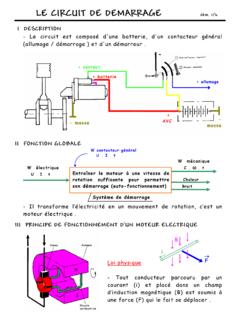Transcription of Policy For Power Generation Projects Year 2002
1 Policy For Power Generation Projects Year 2002 FOREWORD Electricity is the engine for the growth of the economy. Although the surplus Power scenario of the late nineteen-nineties was harmful for the economy, but more damaging were the effects of the long load-shedding hours of the nineteen-eighties. The dark and frightening shadows of load-shedding have again started to loom large. From the year 2003-04, winters are again expected to experience Power shortages. The city of Karachi, with a population base of above one crore, is already bearing the brunt of Power shortages.
2 WAPDA's Power wing is being corporatized, on its way to be privatized. Thus, any future investment in electrical Power is expected from the private sector. The previous Power Policy of 1998, however, had failed to attract the private Power investors. The Government felt it necessary to create an environment and craft a new set of incentives which, on the one hand, offer attraction to investors and, on the other, keep the consumer prices within affordable limits. Keeping in view these targets, this Policy for Power Generation 2002 has been brought out after thorough deliberation and brain-storming among all stakeholders over a period of above two-and-a-half years.
3 The maximum effort has been put in to yield consensus among the stakeholders during drafting this Policy . In the present circumstances, this Policy offers maximum incentives and assurances that an investor can expect. The Government, therefore, invites the investors to invest in the Power sector and assures them its fullest possible support in implementation of their Projects . Mirza Hamid Hassan Secretary Ministry of Water and Power ABBREVIATIONS AEB Area Electricity Board AJK Azad Jammu and Kashmir BOO Build-Own-Operate BOOT Build-Own-Operate-Transfer CBR Central Board of Revenue CPP Capacity Purchase Price CSA Coal Supply Agreement EPP Energy Purchase Price FBS Federal Bureau of Statistics FSA Fuel Supply Agreement GOP Government of Pakistan GSA Gas Supply Agreement IA Implementation Agreement ICB International Competitive Bidding IPP Independent Power
4 Producer IRSA Indus River System Authority KESC Karachi Electric Supply Corporation kV Kilo Volt kW Kilo Watt kWh Kilo Watt Hour LOI Letter of Interest LOS Letter of Support MW Mega Watt NBP National Bank of Pakistan NEPRA National Electric Power Regulatory Authority NTDC National Transmission and Despatch Company PEPA Pakistan Environmental Protection Agency PPA Power Purchase Agreement PPIB Private Power and Infrastructure Board PPC Private Power Cell RFP Request For Proposals Rs Pakistan Rupee SCA Sindh Coal Authority SECP Securities and Exchange Commission of Pakistan SRO Statutory Rules and Orders TFC Term Finance Certificate US$ United States Dollar WAPDA Water and Power Development Authority WPI Wholesale Price Index WUA Water Use Agreement WUL Water Use License TABLE OF CONTENTS 1 Structure of the Power Pakistan Water and Power Development Authority (WAPDA).
5 2 Karachi Electric Supply Corporation (KESC)..2 Regulatory Objectives of the Power Scope of the Power Transition Requirement of Future Generation Features of the Power 2 INSTITUTIONAL National Electric Power Regulatory Authority(NEPRA)..5 Private Power & Infrastructure Board (PPIB)..6 Provincial and AJK PPCs ..6 3 SOLICITED Request for Proposal ..8 Evaluation of 4 PROPOSALS ON RAW Submission of Letter of Negotiations on Participation in Bidding.
6 11 5 THE IMPLEMENTATION Fee Bid Bond, Letter of Support and Performance project 6 Point of Fuel Tariff Currency of Capacity and Energy Water Use and Fuel Exchange Rate Yearly Profile of 7 FINANCIAL AND FISCAL Financial Fiscal 8 SECURITY 9 THE 10 SPECIFIC PROVISIONS FOR HYDEL Water Use Feasibility Hydrological 11 SPECIFIC PROVISIONS FOR THERMAL Indigenous Thermal Projects other than Indigenous 12 PUBLIC PRIVATE 13 PROVISIONS
7 FOR OTHER Projects ..22 Small Power Plants upto 50 MW Small Power Plants Intended to Serve Isolated Areas (Unlikely to be Connected to National Grid)..23 Projects under Previous CONTACT ADDRESS Policy for Power Generation Projects , 2002 Page 1 of 27 INTRODUCTION 1. Electricity constitutes one of the most important components of infrastructure and plays a key role in national growth and development. With only about half of nearly million people (2001 population estimate) having access to electricity, a huge population base provides an ideal opportunity for expansion of electricity Generation .
8 The growing pace of urbanization and industrialization also puts a premium on demand for electricity. 2. Demands for augmenting the Power infrastructure, unsatisfactory performance of public sector entities, ever-squeezing budgets in the public sector, the need to make the tariff free from subsidies and cross-subsidies and reflect market prices etc., provide motivation for resource mobilization, improving efficiency through involvement of the private sector, to reduce the burden on budgetary resources caused by ailing enterprises and more importantly, to meet consumer expectations within affordable limits of tariff.
9 3. Reform of the Power sector through restructuring and deregulation is high on the agenda of the Government of Pakistan (GOP). The GOP is committed to pursue a far-reaching reform programme for the Power sector and to help meet the country's future Power needs. Implementation of the envisaged programme will bring about a gradual transition of the Power system from integrated, state-owned utilities to a decentralized system with separate Generation , transmission and distribution entities, having substantial private ownership and management, reflecting and encouraging a commercial and competitive operating environment.
10 Structure of the Power Sector 4. Pakistan has two vertically integrated public sector Power utilities --- the Pakistan Water and Power Development Authority (WAPDA) and the Karachi Electric Supply Corporation (KESC). WAPDA supplies Power to all of Pakistan, except the metropolitan city of Karachi, which is supplied by KESC. The systems of WAPDA and KESC are interconnected through 220 kv double circuit transmission line. Out of a total Generation capacity of about 17,664 MW in the country, 9,949 MW is owned by WAPDA, 1,756 MW by KESC, 437 MW by the Pakistan Atomic Energy Commission (PAEC) and 5,522 MW by Independent Power Producers (IPPs).











